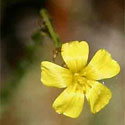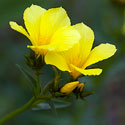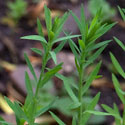|
Linum (flax genus) Life
> eukaryotes >
Archaeoplastida >
Chloroplastida
>
Charophyta > Streptophytina > Plantae (land plants)
> Tracheophyta (vascular plants) > Euphyllophyta > Lignophyta (woody plants)
> Spermatophyta (seed plants) > Angiospermae (flowering
plants) > Eudicotyledons > Core Eudicots > Rosids >
Eurosid I > Order: Malpighiales
> Family: Linaceae
About 230 species (temperate and subtropical regions
worldwide), of which 14 species are native to southern Africa and a further
five species are cultivated in the region.
Linum usitatissimum
(Flax; Linseed), is one of the species cultivated and yields flax from the
stem fibres and linseed oil from the seeds.
Species native to southern Africa
List from
Plants
of Southern Africa - an Online Checklist (SANBI) and
Flora of
Zimbabwe.
Linum acuticarpum |
|
Linum adustum |
|
Linum aethiopicum |
|
Linum africanum |
|
Linum brevistylum |
|
Linum comptonii |
|
Linum esterhuyseniae |
|
Linum gracile |
|
Linum heterostylum |
|
Linum pungens |
|
Linum quadrifolium |
|
Linum thesioides |
|
Linum thunbergii
|
 |
Linum villosum |
|
Other species, cultivated in southern Africa
List from Glen (2002)
Linum flavum
Native to Europe. |
 |
Linum grandiflorum (Flowering
flax)
Native to North Africa. |
|
Linum lewisii
Native to North America. |
|
Linum perenne (Perennial flax)
Native to Europe and North America. |
|
Linum usitatissimum (Flax)
Probably native to Asia and cultivated in southern Africa. Flax is derived from
the stem fibers, which are durable and of high
tensile strength; linseed oil is derived from the seeds and is used in the
manufacture of paints, varnishes and printing ink. |
 |
Publications
|
